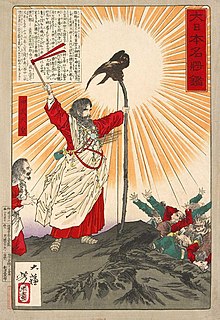Jimmu
Jimmu or Jinmu ( Japanese 神 武天皇 , Jimmu-tennō ; * February 13, 711 BC ( Kōgo ( 庚午 ) / 1/1 ); † April 9, 585 BC (Jimmu 76/3/11) ; actually Kamuyamato Iwarebiko no Mikoto ) was according to the imperial chronicles Kojiki and Nihonshoki of February 18, 660 BC. BC (1st day of the 1st month in the year of the metal rooster ) to 585 BC The mythical first Tennō of Japan .
The name literally means "Divine Power" and was given later when the Japanese emperors began to give themselves Chinese-inspired names. The Japanese imperial family justified its claim to the throne with his descent from Jimmu-tennō.
ancestry
According to legend, Jimmu is the great-great-great-grandson of Amaterasu , the Japanese sun goddess of Shinto , from whom he is said to have received the Three Imperial Insignia (sword, mirror and jewel).
According to Japanese mythology, Amaterasu is said to have had a son named Amenooshihomimi no mikoto and through him a grandson named Ninigi no mikoto. The sun goddess chose her grandson to rule the Japanese islands, where he married Princess Konohanasakuyahime , the younger of the two daughters of the supreme mountain god Ōyamatsumi .
The youngest of the three sons of Ninigi-no-Mikoto and Konohanasakuyahime was Hikohohodemi no mikoto, also called Yamasachi-hiko . He married Princess Toyotama , the dragon daughter of Ōwatatsumi , the Japanese god of the sea and brother Amaterasus.
Hikohohodemi no Mikoto and Toyotama had an only son, Ugayafukiaezu no mikoto. The boy was abandoned by his parents after he was born and raised by Princess Tamayori , a younger sister of his mother. Ugayafukiaezu and his aunt Tamayori eventually married and had many children, one of whom was Jimmu.
His mausoleum ( misasagi ) is the tumulus Unebi-yama-no-ushitora-no-sumi-no-misasagi ( 畝 傍 山東 北陵 , 'Imperial tomb northeast of Mount Unebi'; 34 ° 29 ′ 51 ″ N , 135 ° 47 ′ 17 ″ O ) in Kashihara .
The Japanese historian Ino Okifu identifies Jimmu with the Han Chinese explorer and magician Xu Fu , who is said to have landed in Japan while searching for the elixir of eternal life for Qin Shihuangdi and to have settled there with over 3,000 men and women.
Mythological foundations
Despite the descriptions of the historical environment that took him to the 7th century BC Classify, Jimmu-tennō is a mythical figure in the view of modern history. It seems to be a combination of several princes from ancient Japan.
In 1889 a shrine was built in Kashihara ( Nara Prefecture ) in Jimmu's honor, the Kashihara-jingū .
Memorial days
Traditionally, New Year's Day on the Japanese lunar calendar was celebrated as the anniversary of the beginning of Jimmu-tennō's rule. In 1872 the Meiji government declared February 11, 660 BC. In the Gregorian calendar on the founding day of Japan. This mythical date was celebrated as the holiday Kigensetsu ("day of the government era ") from 1872 until it was abolished by the occupying powers in 1948 . In 1966 this was reintroduced as the holiday Kenkoku Kinen no Hi ("National Foundation Day ").
Web links
- 神 武天皇 . In:デ ジ タ ル 版 日本人 名 大 辞典 + Plus at kotobank.jp. Retrieved March 15, 2015(Japanese).
- Detailed outline of the legend of Jimmu's origins (Japanese)
Notes and sources
- ↑ Dating according to the traditional lunisolar calendar, which was used in Japan until 1873
- ↑ Tony Allan, Michael Kerrigan, Charles Phillips: Sons of the Sun - Japan (= myths of mankind ). Time-Life International, Amsterdam 2002, ISBN 90-5390-818-8 , pp. 70-73
- ↑ 天 皇陵 - 神 武天皇 畝 傍 山東 北陵 . Kunai-chō , accessed October 6, 2017 (Japanese).
- ↑ Liu, Hong. The Chinese Overseas: Routledge Library of Modern China. Published by Taylor & Francis, [2006] (2006). ISBN 0-415-33859-X .
- ↑ Lee, Khoon Choy Lee. Choy, Lee K. [1995] (1995). Japan - between Myth and Reality: Between Myth and Reality. World Scientific publishing. ISBN 981-02-1865-6 .
- ^ Iwo Amelung , Matthias Koch, Joachim Kurtz, Eun-Jeung Lee, Sven Saaler (eds.): Discourses of self-assertion in Asia: China - Japan - Korea (= monographs from the German Institute for Japanese Studies of the Philipp-Franz-von-Siebold-Foundation . Vol. 34). Iudicium-Verlag, Munich 2003, ISBN 3-89129-845-5 .
| predecessor | Office | successor |
|---|---|---|
| - |
Tennō 660-585 BC Chr. |
Suicide |
